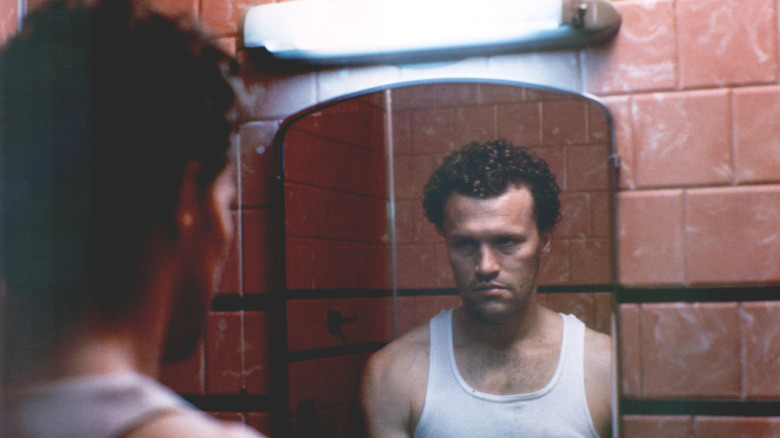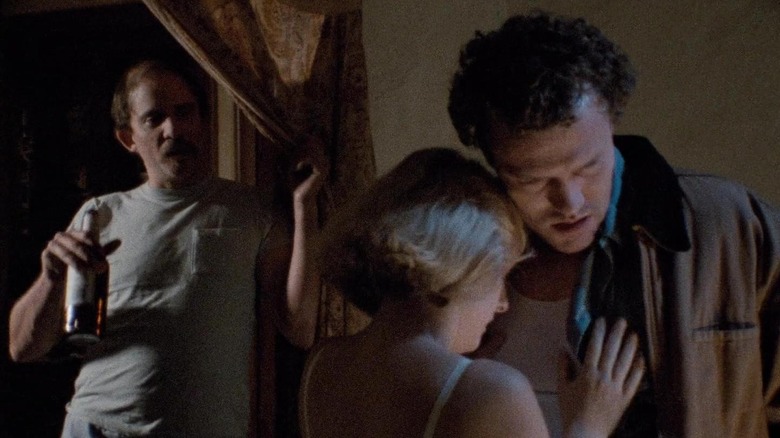Michael Rooker's Breakout Movie Helped Inspire The MPAA's NC-17 Rating
Michael Rooker has been a safe pair of hands in Hollywood supporting roles for almost four decades, proving himself equally adept playing trustworthy sidekicks and sneering villains. For younger movie buffs, he's probably best known as Yondu, Peter Quill's blue-skinned space pirate surrogate dad in the "Guardians of the Galaxy" films. That character eventually leaned towards the more endearing side of his filmography, but that high-profile role in a slick blockbuster trilogy than grossed almost $2.5 billion at the box office was light years away from how viewers first saw him in his breakout role in shocking psychological horror that inspired the MPAA's NC-17 rating.
Rooker was acting in theater and working as a janitor when director John McNaughton told him about his first film project, "Henry: Portrait of a Serial Killer," inspired by the true-life crimes of Henry Lee Lucas. Reportedly, Rooker showed up for the reading in his janitor's uniform, and the movie was so low budget that he wore his own clothes once he was on set. Rooker committed fully to the role, talking to the Texas Rangers who had interviewed the real Henry and staying in character throughout the 28-day shoot. He was so in the zone that his wife held back on revealing they had a baby on the way until after the film had wrapped.
Rooker's method performance and McNaughton's documentary-style approach to the subject certainly added to the gritty realism. Due to lack of funds, the director shot on the fly without permits and used family and friends in supporting roles. This lo-fi nature of "Henry" gives it an unnervingly naturalistic vibe. Indeed, it was the overarching atmosphere rather than its violent content that earned the film a notorious "X" certificate from the MPAA. Clearly something had to change.
What happens in Henry: Portrait of a Serial Killer?
As the title suggests, Henry (Michael Rooker) is a serial killer drifting westwards across the United States, randomly selecting victims and changing his method to keep the cops off the scent. When we meet him, he's working casual jobs and living in a grimy apartment with Otis (Tom Towles), an ex-con he met while they were in prison together. The dynamic changes with the arrival of Becky (Tracy Arnold), Otis's downtrodden sister who was sexually abused by their father as a teen.
Becky takes a shine to Henry and he protects her by fending off an incestuous advance by Otis, which almost ends in a fight. The guys make peace by going out and picking up a couple of sex workers, who Henry kills in front of his flatmate. Otis gets a kick out of it and joins Henry on an increasingly depraved and reckless killing spree. Meanwhile, Becky's amorous feelings toward Henry grow stronger, and it's only a matter of time before the tension between the trio spills over into gruesome violence.
"Henry: Portrait of a Serial Killer" is a harrowing and unflinching chamber piece that puts us suffocatingly close to three deeply damaged people living joyless existences surrounded by moral and economic decrepitude. They are products of their environment, and there is no grand plan or ingenious message to Henry's murders. He just has a complete lack of empathy and a compulsion to kill that serves no purpose but to fill the blankness inside him for a brief moment. That desire is insatiable and there is a grim inevitability to the film's stark conclusion, which dumps us on the side of the road with a blood-stained suitcase and a horror of the void swirling in our minds.
Henry's X-rated certification problems helped bring about the NC-17 rating
"Henry: Portrait of a Serial Killer" premiered at the Chicago International Film Festival in 1986, but the commercial prospects of John McNaughton's film were severely hindered when the MPAA slapped it with an X rating. The adults-only certificate was commonly associated with pornography and distributors shied away, as the film had little potential for a theatrical release with the X attached. Furthermore, the MPAA advised that there was no way to cut material to achieve a less-severe R rating instead.
The violence in "Henry" is disturbing but certainly no more graphic than the type offered up for kicks in the slasher movies of the period, and Roger Ebert went to bat for the film on that basis. He argued that a sincere work of art that took violence seriously didn't deserve exile from cinemas while other horror movies regularly trivialized it. Both Ebert and his fellow critic Gene Siskel advocated an A certificate, indicating a film was strictly for adults only without the pornographic stigma of the X certificate. Ultimately, a groundswell of support for a new certificate led the MPAA to introduce the NC-17 rating and "Henry: Portrait of a Serial Killer" received its U.S. premiere in January 1990 without any cuts. This was a minor triumph for McNaughton, who admitted that he would have excised offending material if the censors had asked for them.
It was also to the benefit of mature viewers who can handle uncompromising filmmaking like "Henry." It's definitely not a fun watch and lands especially hard in retrospect — serial killer movies and grisly true crime shows have become disposable popcorn entertainment. The film is admirable for its total refusal to allow the audience any kind of vicarious thrill from Henry and Otis's actions; it is blunt, ugly, and nihilistic, which also makes it one of the best movies about real-life serial killers ever made.


